|
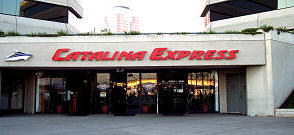 About
a million tourists visit the island every year; Catalina is serviced by
ferries and the "Airport in the Sky." About
a million tourists visit the island every year; Catalina is serviced by
ferries and the "Airport in the Sky."
Enjoy swimming, snorkeling, kayaking, golfing, sightseeing tours,
strolling through the quaint shops, the museum and art galleries, dining
at seaside restaurants or just relaxing on the beach.
Getting there:
-
Catalina Express - Long Beach / San Pedro/Dana Point
Travel in comfort and style on board the Catalina Express to
beautiful Catalina Island and city of Avalon, a Mediterranean-like
town just 22 miles off the coastline of Southern California and
noted for its climate, ocean sports and friendly charm. From Long
Beach, San Pedro or Dana Point you'll travel aboard the fastest
fleet of state-of-the-art passenger vessels arriving in about an
hour.
-
Catalina Passenger Service, Inc. - Catalina Flyer
The Luxurious Catalina Flyer is the largest passenger-carrying
catamaran on the West Coast and features a richly appointed
interior, sweeping sun decks, full-service cocktail lounges, stately
viewing windows and Ride Control for a smooth, comfortable crossing.
So if you want comfort, service, a friendly crew, or just want to
work on your tan, the Catalina Flyer is your choice.
Most of the island is controlled by the Catalina Island Conservancy,
 a
private nonprofit organization. The mission of the Catalina Island
Conservancy is to be a responsible steward of its lands through a
balance of conservation, education and recreation. Through its ongoing
efforts, the Conservancy protects the magnificent natural and cultural
heritage of Santa Catalina Island, stewarding approximately 42,000 acres
(170 km²) of land (88 percent of the island), 50 miles (80 km) of rugged
shoreline, an airport, and more than 200 miles of roads. a
private nonprofit organization. The mission of the Catalina Island
Conservancy is to be a responsible steward of its lands through a
balance of conservation, education and recreation. Through its ongoing
efforts, the Conservancy protects the magnificent natural and cultural
heritage of Santa Catalina Island, stewarding approximately 42,000 acres
(170 km²) of land (88 percent of the island), 50 miles (80 km) of rugged
shoreline, an airport, and more than 200 miles of roads.
 Under
an agreement with Los Angeles County, the Conservancy has granted an
easement to allow day hiking and mountain biking, but visitors must
first obtain a permit at the Conservancy's office (on which they declare
the parts of the island they intend to visit). Hiking permits are free,
whereas bicycle permits are available for a fee (as of 2006, $60 per
person annual, $20 per person good for 2 consecutive days, helmets and
mountain bikes with knobby tires required). Under
an agreement with Los Angeles County, the Conservancy has granted an
easement to allow day hiking and mountain biking, but visitors must
first obtain a permit at the Conservancy's office (on which they declare
the parts of the island they intend to visit). Hiking permits are free,
whereas bicycle permits are available for a fee (as of 2006, $60 per
person annual, $20 per person good for 2 consecutive days, helmets and
mountain bikes with knobby tires required).
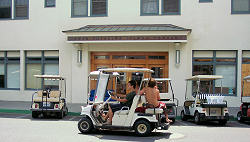 The
use of motor vehicles on the island is restricted; there is limit on the
number of registered cars, which translates into a 10-year-long wait
list to bring a car to the island. Most residents move around via golf
cart. Tourists can hire a taxi from Catalina Transportation Services.
Bicycles are also a popular mode of transportation. There are a number
of bicycle and golf cart rental agencies on the island. Only the city of
Avalon is open to the public without restrictions. The
use of motor vehicles on the island is restricted; there is limit on the
number of registered cars, which translates into a 10-year-long wait
list to bring a car to the island. Most residents move around via golf
cart. Tourists can hire a taxi from Catalina Transportation Services.
Bicycles are also a popular mode of transportation. There are a number
of bicycle and golf cart rental agencies on the island. Only the city of
Avalon is open to the public without restrictions.
The only major road into the back country is Stage Road.
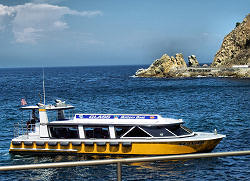 Glass
bottom boats tour the reefs and shipwrecks of the area, and scuba diving
and snorkeling are popular in the clear water. Lover's Cove, to the east
of town, and Descanso Beach, to the west of the Casino, are popular
places to dive. The area is famous for the schools of flyingfish and the
bright orange Garibaldi which teem in local waters. Bus tours are given
of the interior. Glass
bottom boats tour the reefs and shipwrecks of the area, and scuba diving
and snorkeling are popular in the clear water. Lover's Cove, to the east
of town, and Descanso Beach, to the west of the Casino, are popular
places to dive. The area is famous for the schools of flyingfish and the
bright orange Garibaldi which teem in local waters. Bus tours are given
of the interior.
While tourists rarely have an opportunity to surf, two beaches on the
"backside" of Catalina offer good waves: Shark Harbor and Ben Weston
Beach.
Two Harbors is the second, and much smaller, resort village on the
island. Located at the isthmus of the island, north of Avalon, it is the
primary landing spot for those who wish to tour the western half of the
island. It is accessible by boat from San Pedro and by bus or boat from
Avalon.
Art Good, host of the Jazztrax Showcase of the Absolute Newest, holds
the Catalina Island Jazztrax Festival there each year.
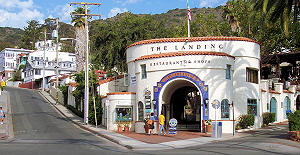 The
Catalina Island Museum, located in the historic Casino Building, is also
an attraction as it is the keeper of the the island's cultural heritage
with collections numbering over 100,000 items and including over 7,000
years of Native American history, over 10,000 photographs and images, a
large collection of Catalina-made pottery and tile, ship models, and
much more. The museum features dynamic exhibits on this history and also
a unique gift store. Programs include walking tours of Avalon, classes
for students, gallery docents, lectures, an annual silent film benefit
and more. The
Catalina Island Museum, located in the historic Casino Building, is also
an attraction as it is the keeper of the the island's cultural heritage
with collections numbering over 100,000 items and including over 7,000
years of Native American history, over 10,000 photographs and images, a
large collection of Catalina-made pottery and tile, ship models, and
much more. The museum features dynamic exhibits on this history and also
a unique gift store. Programs include walking tours of Avalon, classes
for students, gallery docents, lectures, an annual silent film benefit
and more.
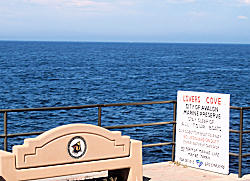 Two
Boy Scouts of America councils in Los Angeles County have camps north of
Two Harbors: Camp Cherry Valley, operated by the San Gabriel Valley
Council, located two coves north of Two Harbors at Cherry Cove; and Camp
Emerald Bay, operated by the Western Los Angeles County Council, further
up the coast. Two
Boy Scouts of America councils in Los Angeles County have camps north of
Two Harbors: Camp Cherry Valley, operated by the San Gabriel Valley
Council, located two coves north of Two Harbors at Cherry Cove; and Camp
Emerald Bay, operated by the Western Los Angeles County Council, further
up the coast.
The island contains a YMCA summer camp named Camp Fox, operated by YMCA
of Glendale, which holds several summer coed youth camps, a summer
girl's camp, as well as a Christian leadership conference in spring.
There is also Campus by the Sea, a camp operated by InterVarsity
Christian Fellowship, located at Gallagher's Cove.
There is also a coeducational camp at Howland's Landing named Catalina
Island Camps, which has been there since the 1920s. Catalina Island
Camps is home to many camps including Camp del Corazone, a camp for kids
and counselors with heart disease or defects.
Guided Discoveries also runs several camps on Catalina Island providing
hands on opportunities to learn marine science and environmental studies
to school groups and community groups during school year and sea camps
during the summer.
In an effort to generate tourism towards Catalina, William Wrigley Jr.
tried to convince Gertrude Ederle, who had just become famous as first
woman to swim across the English Channel in 1926, to swim from Catalina
to the mainland which was roughly the same distance.
 She
declined, so he launched the 1927 Wrigley Ocean Marathon: offering
$25,000 to the first person to cross the channel, with $15,000 for the
first finisher of "the fair sex." Out of a field of 102, only one man
finished, Canadian swimmer George Young, finishing 15 hours and 44
minutes after the start. The two women who came the closest were awarded
$2,500 each.[7] She
declined, so he launched the 1927 Wrigley Ocean Marathon: offering
$25,000 to the first person to cross the channel, with $15,000 for the
first finisher of "the fair sex." Out of a field of 102, only one man
finished, Canadian swimmer George Young, finishing 15 hours and 44
minutes after the start. The two women who came the closest were awarded
$2,500 each.[7]
In 1936, Ronald Reagan, as a young radio announcer for WHO in Des
Moines, Iowa, traveled to Catalina to cover the Cubs during spring
training. While there, he took a screen test and was offered an acting
role.
After visiting Catalina Island, Jack Owens, the Cruising Crooner, a
popular radio vocalist of Don McNeil's Breakfast Club, was inspired by
the friendly greeting people used there, "Hi, Neighbor," and wrote the
music and words in 1941 for a song of the same name, and it went on to
be a top-selling pop tune that year.
In the early 1940s during World War II, Marilyn Monroe, as a young,
married woman, briefly lived in Avalon with her first husband, James
Dougherty, a lieutenant in the Merchant Marine, who was stationed on the
island. Monroe often was a babysitter for neighborhood children.
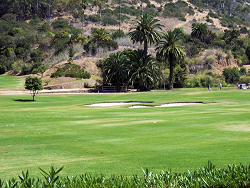 On
May 31, 1950, actor Gregory Harrison was born at Avalon on Santa
Catalina Island. His father, Ed Harrison, operated a glass-bottom boat
sightseeing service on the island. Harrison went on to star in many
stage, screen and television productions, including Logan's Run, Trapper
John, M.D., Centennial, and It's My Party. In 1980, Harrison and a
partner founded an entertainment production company, the Catalina
Production Group Ltd., named after his island birthplace. On
May 31, 1950, actor Gregory Harrison was born at Avalon on Santa
Catalina Island. His father, Ed Harrison, operated a glass-bottom boat
sightseeing service on the island. Harrison went on to star in many
stage, screen and television productions, including Logan's Run, Trapper
John, M.D., Centennial, and It's My Party. In 1980, Harrison and a
partner founded an entertainment production company, the Catalina
Production Group Ltd., named after his island birthplace.
In 1958, the Four Preps recorded the hit song "26 Miles (Santa
Catalina)"; the song reached the #2 position on the U.S. popular music
charts.
The 1966 romantic comedy film The Glass Bottom Boat, starring Doris Day
and Rod Taylor, was filmed on Catalina Island.
The 1967 teen comedy film Catalina Caper, starring Tommy Kirk, was
filmed on Catalina Island. This movie was later featured in episode 204
of Mystery Science Theater 3000.
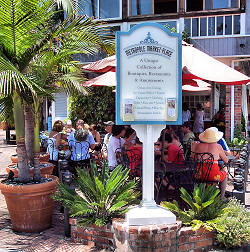 Several
scenes from the 1974 film Chinatown, starring Jack Nicholson and Faye
Dunaway, were filmed on Catalina, including one showing the Casino. Several
scenes from the 1974 film Chinatown, starring Jack Nicholson and Faye
Dunaway, were filmed on Catalina, including one showing the Casino.
Actress Natalie Wood drowned off the coast of Catalina in 1981 while on
a boating trip with husband Robert Wagner and actor Christopher Walken.
Catalina Island is briefly mentioned in the 1987 movie Lethal Weapon as
the place where Roger (Danny Glover) would like to fish with his new
boat.
The 1988 film Who Framed Roger Rabbit featured an oft-referenced
vacation to Catalina Island as a subject in the failing relationship
between Eddie Valiant and Dolores.
In 1982 Descendents released the album Milo Goes to College, featuring a
song called "Catalina."
In 1989 actor Chad Allen is seen visiting Catalina Island in the
promotional video The Real Chad Allen. Allen is seen visiting Avalon
there and also snorkeling off the coast in the vicinity of a sunken
ship.
 In
1998, actor Phil Hartman was fatally shot by his wife Brynn Hartman, who
committed suicide several hours after the murder. The couple's ashes
were scattered in Emerald Bay off the coast of Santa Catalina Island as
specified in Hartman's will. In
1998, actor Phil Hartman was fatally shot by his wife Brynn Hartman, who
committed suicide several hours after the murder. The couple's ashes
were scattered in Emerald Bay off the coast of Santa Catalina Island as
specified in Hartman's will.
The final scenes of the 1998 film Billy's Hollywood Screen Kiss takes
place on Catalina Island. The film closes with a song titled Love Slave
of Catalina.
In Dan Brown's popular novel Deception Point, published in 2001, there
is a reference to sailing off the coast of Catalina.
In Sandra Byrd's Faithful Friends: The Hidden Diary Series (published in
2001), the main setting and location for all the books is Catalina
Island.
In 2002, the TV show Endurance was filmed on the island.
In a season one episode of the Fox series Arrested Development entitled
"Staff Infection," employees of the Bluth Company get lost on Catalina
Island, and are found and transported by a sheep herder in his animal
trailer.
In the fictional novel, A Darkness More Than Night, by Michael Connelly,
Catalina Island is featured extensively.
The 2006 TV Comedy Falling in Love with the Girl Next Door, featuring
Crystal Allen, Ken Marino and Patrick Duffy takes place in Catalina
Island.
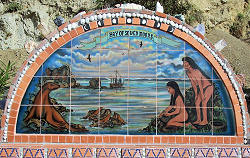 Prior
to the modern era the island was inhabited by people of the Gabrielino/Tongva
tribe, who also lived in the area of Los Angeles, had villages near
present day San Pedro and Playa del Rey, and who regularly traveled back
and forth to Catalina for trade. The Tongva called the island Pimu or
Pimungna. The Gabrielino/Tongva are renowned for their mining, working
and trade of soapstone which was found in great quantities and varieties
on the Island. This material was in great demand and was traded along
the California coast. Prior
to the modern era the island was inhabited by people of the Gabrielino/Tongva
tribe, who also lived in the area of Los Angeles, had villages near
present day San Pedro and Playa del Rey, and who regularly traveled back
and forth to Catalina for trade. The Tongva called the island Pimu or
Pimungna. The Gabrielino/Tongva are renowned for their mining, working
and trade of soapstone which was found in great quantities and varieties
on the Island. This material was in great demand and was traded along
the California coast.
The first European to set foot on the island was Portuguese explorer
Juan Rodriguez Cabrillo, sailing for Spain. This happened on October 7,
1542. He claimed the island for Spain and christened it San Salvador.
Another Spanish explorer, Sebastian Vizcaino, rediscovered the island on
the eve of Saint Catherine's day (November 24) in 1602. He renamed it
Santa Catalina to honor the feast day of St. Catherine of Alexandria.
 During
the following 300 years, the island served as home or base of operation
for many visitors, from Russian otter hunters to Spanish smugglers to
Chinese pirates. Franciscan monks tried to build a mission there, but
failed due to the lack of fresh water on the island. The native
population was mostly wiped out by disease during 19th century. Catalina
Island experienced a brief period of gold rush in 1860s, but no gold was
found and only a little silver. In 1864, the federal government, fearing
attempts to outfit privateers by Confederate sympathizers in the
American Civil War, put an end to the mining by ordering everyone off
the island. A small garrison of Union troops occupied the Catalina for
about nine months. (Their barracks stood until the 1940s, when they were
destroyed in a fire.) During
the following 300 years, the island served as home or base of operation
for many visitors, from Russian otter hunters to Spanish smugglers to
Chinese pirates. Franciscan monks tried to build a mission there, but
failed due to the lack of fresh water on the island. The native
population was mostly wiped out by disease during 19th century. Catalina
Island experienced a brief period of gold rush in 1860s, but no gold was
found and only a little silver. In 1864, the federal government, fearing
attempts to outfit privateers by Confederate sympathizers in the
American Civil War, put an end to the mining by ordering everyone off
the island. A small garrison of Union troops occupied the Catalina for
about nine months. (Their barracks stood until the 1940s, when they were
destroyed in a fire.)
 By
the end of 19th century, the island was almost uninhabited except for a
few cattle herders. At that time, its location just 20 miles from Los
Angeles—the city that had reached the population of 50,000 in 1890 and
was undergoing the period of enormous growth—was a major factor that
contributed to the development of the island into a vacation
destination. By
the end of 19th century, the island was almost uninhabited except for a
few cattle herders. At that time, its location just 20 miles from Los
Angeles—the city that had reached the population of 50,000 in 1890 and
was undergoing the period of enormous growth—was a major factor that
contributed to the development of the island into a vacation
destination.
The first owner to try to develop Avalon into a resort destination was
George Shatto, a real estate speculator from Grand Rapids, Michigan, who
purchased the Island for $200,000 at the height of the real estate boom
in Southern California in 1887[2]. Shatto created the settlement that
would become Avalon, and can be credited with building the town's first
hotel, the original Hotel Metropole, and pier[2]. His sister-in-law Etta
Whitney came up with the name Avalon, which was pulled as a reference
from Lord Alfred Tennyson's poem "Idylls of the King," which was about
the legend of King Arthur. Despite Shatto's efforts, in a few years he
had to default on his loan and the island went back to the Lick estate.
 The
sons of Phineas Banning bought the island in 1891 from the estate of
James Lick and established the Santa Catalina Island Company to develop
it as a resort. They built a home at what is now Twin Harbors, and is
now that village's hotel. Their efforts were set back on November 29,
1915 when a fire burned half of Avalon's buildings, including six hotels
and several clubs. World War I also hampered tourism, and the Banning
brothers were forced to sell the island. The
sons of Phineas Banning bought the island in 1891 from the estate of
James Lick and established the Santa Catalina Island Company to develop
it as a resort. They built a home at what is now Twin Harbors, and is
now that village's hotel. Their efforts were set back on November 29,
1915 when a fire burned half of Avalon's buildings, including six hotels
and several clubs. World War I also hampered tourism, and the Banning
brothers were forced to sell the island.
 William
Wrigley, Jr. bought controlling interest in the Santa Catalina Island
Company in 1919 and devoted himself to preserving and promoting it,
investing millions in needed infrastructure and attractions. In 1921 he
sold lots for building in the town of Avalon. The tourism industry was
encouraged by the construction of a beautiful Art Deco dance hall,
called the Casino, in 1929. The Casino was 140-feet high when it was
built and was the tallest building in Los Angeles County at the time.
Surrounded by sea on three sides, the circular Art Deco structure stands
the equivalent of 12 stories tall. Avalon Theater, on the first level,
shows first-run movies nightly, and the theater's original Page Organ
still plays before the show. The circular domed ceiling has remarkable
acoustics studied by experts from around the world. The upper level
houses the world's largest circular ballroom with a 180 foot diameter
dance floor. French doors encircle the room, and balcony views are
spectacular. The text of a postcard postmarked August 1947 reads, "the
gorgeous Catalina Island Casino is a two million dollar 'Palace of
Pleasure' located midway between Hotel St. Catherine and the town of
Avalon. It is the only building of its size in the world, erected on a
full circular plan. A mammoth motion picture theater is on the ground
floor and above the worlds largest circular ballroom." Wrigley put in
circular ramps instead of stairs, an idea taken from his Chicago Cubs
stadium. The ramps allowed the large numbers of people using the
ballroom to quickly move to and from their destinations without accident
or injury. The upstairs dance floor has a capacity of over 6,000
dancers, and sits above the glamorous Avalon Theater, which seats 1,150
and is the first ever designed specifically for sound movies. The
upstairs dance floor is also used by the local high school basketball
team making it one of the plushest and most expensive basketball courts
ever. It is so well insulated that theater patrons cannot hear the band
playing or the 6,000+ partying dancers on the floor above, yet the
excellent acoustics are so good that a speaker on the theater stage can
speak in a normal voice without a microphone and be heard clearly by
everyone in the theater, including those in the back rows. While the
theater shows movies almost exclusively, it has the capabilities to host
theatrical productions as well. The Casino's name derives from a more
traditional Italian definition of casino, meaning social gathering
place; the building has never served as a gambling establishment and for
many years did not even serve alcoholic beverages. William
Wrigley, Jr. bought controlling interest in the Santa Catalina Island
Company in 1919 and devoted himself to preserving and promoting it,
investing millions in needed infrastructure and attractions. In 1921 he
sold lots for building in the town of Avalon. The tourism industry was
encouraged by the construction of a beautiful Art Deco dance hall,
called the Casino, in 1929. The Casino was 140-feet high when it was
built and was the tallest building in Los Angeles County at the time.
Surrounded by sea on three sides, the circular Art Deco structure stands
the equivalent of 12 stories tall. Avalon Theater, on the first level,
shows first-run movies nightly, and the theater's original Page Organ
still plays before the show. The circular domed ceiling has remarkable
acoustics studied by experts from around the world. The upper level
houses the world's largest circular ballroom with a 180 foot diameter
dance floor. French doors encircle the room, and balcony views are
spectacular. The text of a postcard postmarked August 1947 reads, "the
gorgeous Catalina Island Casino is a two million dollar 'Palace of
Pleasure' located midway between Hotel St. Catherine and the town of
Avalon. It is the only building of its size in the world, erected on a
full circular plan. A mammoth motion picture theater is on the ground
floor and above the worlds largest circular ballroom." Wrigley put in
circular ramps instead of stairs, an idea taken from his Chicago Cubs
stadium. The ramps allowed the large numbers of people using the
ballroom to quickly move to and from their destinations without accident
or injury. The upstairs dance floor has a capacity of over 6,000
dancers, and sits above the glamorous Avalon Theater, which seats 1,150
and is the first ever designed specifically for sound movies. The
upstairs dance floor is also used by the local high school basketball
team making it one of the plushest and most expensive basketball courts
ever. It is so well insulated that theater patrons cannot hear the band
playing or the 6,000+ partying dancers on the floor above, yet the
excellent acoustics are so good that a speaker on the theater stage can
speak in a normal voice without a microphone and be heard clearly by
everyone in the theater, including those in the back rows. While the
theater shows movies almost exclusively, it has the capabilities to host
theatrical productions as well. The Casino's name derives from a more
traditional Italian definition of casino, meaning social gathering
place; the building has never served as a gambling establishment and for
many years did not even serve alcoholic beverages.
From 1927 through 1937 pottery and tile were made on the island, and
these items are now considered collectibles. The Chicago Cubs, also
owned by Wrigley, used the island for the team's spring training from
ca. 1920-1950, absent the war years of 1942-45.
During World War II, the island was closed to tourists and used as a
military training facility.[3]
Catalina's airport, the "Airport in the Sky" (AVX), was completed in
1946. The 3,250-foot (990-meter) runway sits on a mountaintop, 1,602
feet (488 m) above sea level. Up until the time of the airport's
construction, the only air service to the island was provided by
seaplanes.
 In
1972, the Brown Berets, a group of Hispanic activists seized the island,
citing the Guadalupe Hidalgo Treaty, a treaty between Mexico and USA by
which Mexico sold more than half of its territory and arguing it does
not specifically mention of the islands. The US had occupied them since
1852 and it had been speculated that Mexico could claim the islands and
seek their return through litigation before the International Court of
Justice. But a detailed analysis of its situation puts in doubt the
likelihood of Mexico winning the case at the International Court of
Justice. In
1972, the Brown Berets, a group of Hispanic activists seized the island,
citing the Guadalupe Hidalgo Treaty, a treaty between Mexico and USA by
which Mexico sold more than half of its territory and arguing it does
not specifically mention of the islands. The US had occupied them since
1852 and it had been speculated that Mexico could claim the islands and
seek their return through litigation before the International Court of
Justice. But a detailed analysis of its situation puts in doubt the
likelihood of Mexico winning the case at the International Court of
Justice.
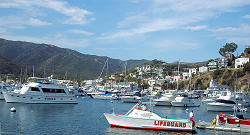 In
1975, Philip Wrigley deeded the Wrigley shares in the Santa Catalina
Island Company to the Catalina Island Conservancy that he had helped
create. The Conservancy now stewards 88 percent of the island. The
mission of the Catalina Island Conservancy is to be a responsible
steward of its lands through a balance of conservation, education and
recreation. So far, the successes include the opening of California's
first permanent desalination plant in 1991. In
1975, Philip Wrigley deeded the Wrigley shares in the Santa Catalina
Island Company to the Catalina Island Conservancy that he had helped
create. The Conservancy now stewards 88 percent of the island. The
mission of the Catalina Island Conservancy is to be a responsible
steward of its lands through a balance of conservation, education and
recreation. So far, the successes include the opening of California's
first permanent desalination plant in 1991.
Known shipwrecks in the waters off the island include the Diosa del Mar
(33.462770° N 118.491925° W), which was sunk July 30, 1990 near Ship
Rock.
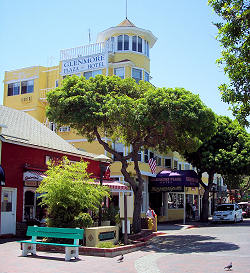 According
to Sunset magazine, "Catalina...is a geographic anomaly. Unlike
California's other seven Channel Islands, it didn't break away from the
mainland, but was formed by the upward heave of tectonic plates." The
island is very rich in quartz and silver, to the point that some beaches
on the seaward side have silvery-grey sand. According
to Sunset magazine, "Catalina...is a geographic anomaly. Unlike
California's other seven Channel Islands, it didn't break away from the
mainland, but was formed by the upward heave of tectonic plates." The
island is very rich in quartz and silver, to the point that some beaches
on the seaward side have silvery-grey sand.
Catalina is primarily composed of two distinct rock units, Catalina
Schist from the Cretaceous and volcanic and intrusive igneous rocks from
the Tertiary period.
About 400 species of native plants grow on the island[5]. Six species,
subspecies or varieties are endemic and can be found only on Catalina
Island. These plants are: Catalina manzanita (Arctostaphylos catalinae);
Catalina mahogany (Cercocarpus traskiae); Catalina dudleya (Dudleya
hassei); St. Catherine’s lace (Eriogonum giganteum var. giganteum);
Santa Catalina bedstraw (Galium catalinense ssp. catalinense); and Santa
Catalina Island ironwood (Lyonothamnus floribundus ssp. floribundus).
These plants may be seen at the Island's Wrigley Memorial & Botanical
Gardens.
The island is home to five endemic mammals, among them, the Catalina
Island Fox and Beechey Ground Squirrel. The Island Fox is an endangered
endemic species. In 1999 all but 100 out of 1,300 foxes on Catalina
Island were wiped out due to a virulent strain of canine distemper.
Following a successful recovery program which included captive breeding,
distemper vaccinations and population monitoring, the Catalina fox
community has been restored to more than 400 individuals—a number deemed
by the Conservancy scientists to be a self-sufficient population.[6]
However, mysterious, usually fatal ear tumors continue to plague the
Catalina fox. Three Catalina Island Conservancy wildlife biologists
continue to monitor the population through pit tagging, trapping and
inspection.
A herd of American Bison roam, supposedly first imported in 1924 for the
silent film version of Zane Grey's Western tale "The Vanishing
American." Over the decades, the bison herd grew to as many as 600
individuals. Bison were routinely removed and sent to the mainland to
auction. Recently however, another solution was implemented. The
Conservancy initiated a scientific study that determined that a herd of
between 150 and 200 would be good for the bison, and ecologically sound
for the Island. In 2004, the Conservancy partnered with the Morongo Band
of Mission Indians, the Tongva (thought to be Catalina's original
inhabitants some 4,000 years ago), and the Lakota tribe on the Rosebud
Reservation in South Dakota. A hundred bison were relocated "home" to
the Great Plains. The Conservancy plans to pursue a similar plan when
the bison population exceeds 200 individuals. Although the bison are not
native to the Island, they comprise an important role in the cultural
fabric of Catalina. Therefore the Conservancy has no plans to remove all
the animals from the Island.
The Conservancy is also working to restore bald eagles to the Island.
 In
the waters surrounding the island, there are schools of fish like
garibaldi, Yellowtail, Calico Bass, White seabass, Giant sea bass,
Leopard sharks, blacksmiths, opaleyes and many more. In
the waters surrounding the island, there are schools of fish like
garibaldi, Yellowtail, Calico Bass, White seabass, Giant sea bass,
Leopard sharks, blacksmiths, opaleyes and many more.
More from
Wikipedia
Return to
GoThere.com |

